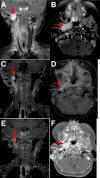Infantile Fibrosarcoma With NTRK3-ETV6 Fusion Successfully Treated With the Tropomyosin-Related Kinase Inhibitor LOXO-101
- PMID: 27093299
- PMCID: PMC5074243
- DOI: 10.1002/pbc.26026
Infantile Fibrosarcoma With NTRK3-ETV6 Fusion Successfully Treated With the Tropomyosin-Related Kinase Inhibitor LOXO-101
Abstract
Infantile fibrosarcoma (IFS) is a rare pediatric cancer typically presenting in the first 2 years of life. Surgical resection is usually curative and chemotherapy is active against gross residual disease. However, when recurrences occur, therapeutic options are limited. We report a case of refractory IFS with constitutive activation of the tropomyosin-related kinase (TRK) signaling pathway from an ETS variant gene 6-neurotrophin 3 receptor gene (ETV6-NTRK3) gene fusion. The patient enrolled in a pediatric Phase 1 trial of LOXO-101, an experimental, highly selective inhibitor of TRK. The patient experienced a rapid, radiographic response, demonstrating the potential for LOXO-101 to provide benefit for IFS harboring NTRK gene fusions.
Keywords: ETV6-NTRK3; LOXO-101; gene fusion; infantile fibrosarcoma; tropomyosin-related kinase (TRK).
© 2016 The Authors. Pediatric Blood & Cancer, published by Wiley Periodicals, Inc.
Figures

References
-
- Chung EB, Enzinger FM. Infantile fibrosarcoma. Cancer 1976;38:729–739. - PubMed
-
- Loh ML, Ahn P, Perez‐Atayde AR, Gebhardt MC, Shamberger RC, Grier HE. Treatment of infantile fibrosarcoma with chemotherapy and surgery: Results from the Dana‐Farber Cancer Institute and Children's Hospital, Boston. J Pediatr Hematol Oncol 2002;24:722–726. - PubMed
-
- Orbach D, Brennan B, De Paoli A, Gallego S, Mudry P, Francotte N, van Noesel M, Kelsey A, Alaggio R, Ranchere D, De Salvo GL, Casanova M, Bergeron C, Merks JH, Jenney M, Stevens MC, Bisogno G, Ferrari A. Conservative strategy in infantile fibrosarcoma is possible: The European paediatric Soft tissue sarcoma Study Group experience. Eur J Cancer 2016;57:1–9. - PubMed
-
- Orbach D, Rey A, Cecchetto G, Oberlin O, Casanova M, Thebaud E, Scopinaro M, Bisogno G, Carli M, Ferrari A. Infantile fibrosarcoma: Management based on the European experience. J Clin Oncol 2010;28:318–323. - PubMed
-
- Lannon CL, Sorensen PH. ETV6‐NTRK3: A chimeric protein tyrosine kinase with transformation activity in multiple cell lineages. Semin Cancer Biol 2005;15:215–223. - PubMed
Publication types
MeSH terms
Substances
LinkOut - more resources
Full Text Sources
Other Literature Sources

